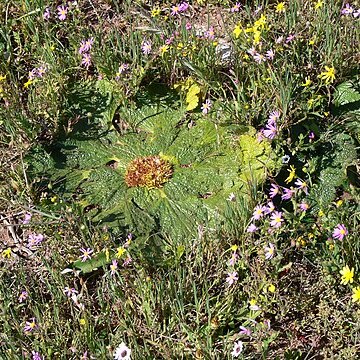Dioecious, acaulescent perennial. Root large, tuberous, resinous. Leaves large, prostrate, ovate to orbicular and lobed to lacerate, margins toothed, prominent, inflexed spines in leaf recesses, bases narrow. Male flowers pedunculate, cream-coloured. Female flowers sessile, greenish. Involucel bracts prominent, ovate, apex acute, keeled, with 1 or 2 inflexed lateral spines, not much enlarging and leathery in fruit. Fruit slightly dorsally compressed, usually with one mericarp aborted, mericarps spiny, separating, vittae absent, rib oil ducts small.
Dioecious, acaulescent perennial; root large, tuberous, resinous. Leaves large, prostrate,± orbicular, lobed to lacerate, toothed, with inflexed spines in leaf recesses. Male flowers pedunculate, cream-coloured. Female flowers sessile, greenish. Involucel bracts prominent, ovate, apex acute, keeled. Fruit slightly dorsally compressed, usually with one mericarp aborted, mericarps spiny, brown, separating when mature, homomorphic, vittae absent, rib oil ducts small.
Dioecious, acaulescent, perennial herb, up to 0.1 m high. Leaves large, prostrate, ovate to orbicular and lobed to lacerate, with bristly margins and erect spines among bristles. Flowers at ground level in simple umbels, cream-coloured to pink, female involucral bracts pungent with 1 or 2 inflexed, lateral spines, united below, not enlarging much in fruit. Flowering time May-July. Fruit prickly due to coalesced bracteoles.

